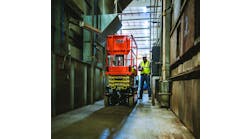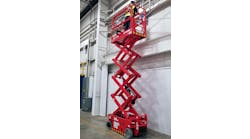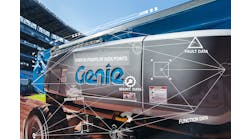Unlike his predecessors at United Rentals, Michael Kneeland is a 30-year rental industry veteran. Although he takes the reins at United during a challenging economic downturn, Kneeland is optimistic about United’s prospects and passionate about the rental industry. RER’s Michael Roth recently sat down with Kneeland for an exclusive interview about the economy, new directions at United Rentals, soccer, Winston Churchill and more.
RER: Let’s talk about some of the challenges you have faced since taking over on an interim basis for Wayland Hicks. You faced a challenging time after the collapse of the Cerberus deal and the dramatic drop in the stock price. How did you reassure investors, maintain morale at the company and keep operations running smoothly at United Rentals?
Kneeland: The strategic alternatives process obviously took a surprising turn, but it didn’t disrupt our focus. Earlier in the year we put a new strategy in place that refocused our operations on equipment rental and emphasized fleet management and cost control. It doesn’t matter whether we are public or private — our strategy was viable then and now. So there was a fundamental continuity in place, which kept the fourth quarter drama from affecting customer service. We also made sure that we communicated with employees as frequently as possible, and externally we met with the investment community as soon as it was appropriate.
You’ve been very successful this year, it appears, at cutting costs. What have been some of the more successful cost-cutting measures?
We’re pleased with the progress we have made so far, but there is a lot more to do. We have a strategic sourcing initiative in place that has realized $29 million in savings on non-rental purchases in its first 24 months; we estimate that there is another $41 million we can cut by streamlining our supplier relationships.
We closed or consolidated approximately 30 marginal branches this year through September as part of our branch optimization program. We also made some workforce reductions, the bulk of which came in 2007. We are very sensitive to the fact that equipment rental is a service business, and we don’t take workforce reductions lightly. The reality is that a more stringent approach to cost control has made us a stronger company, which is better for our customers.
How do you address the challenge of maintaining strong customer service while having to reduce headcount?
Our focus on cost control is pervasive: some reductions came from the field, but also came from the corporate strata. We are very much aware of the customer service implications, and our customer surveying indicates that we have successfully kept our service levels intact. Our employees deserve 100 percent of the credit for that.
Are there any other achievements for United Rentals over the past year that perhaps people in the industry haven’t paid much attention to?
One achievement that is extremely significant is in the area of fleet management. We have implemented a sea change in the way our branches manage the rental fleet — instead of each branch manager having his or her own fleet, there is now a strong financial incentive for our branch managers to share equipment among branches. In effect, we have torn down the walls that impeded our fleet from being utilized most efficiently.
We have also significantly increased our fleet transfers this year compared with 2007, both through the physical redeployment of units to other markets, and by selling fleet in one region and investing the replacement capex elsewhere. Right now the bulk of sharing and transfers take place within a district, but the process is getting increasingly fluid. An extreme example of this was Hurricane Ike in September, where we were a first responder. We transferred 70 truckloads of fleet from 21 states and one Canadian province in the first week after landfall, and deployed it in the Gulf.
Has sharing of equipment between branches been a major source of savings for you?
I would characterize it as being driven by our customers — our fleet goes where our customers need it the most. So yes, there is an economic component but we also transfer fleet to support large project starts, disaster recovery efforts, seasonal shifts, and for many other reasons. In Canada, for example, where the current construction economy is stronger than in the U.S., fleet transfers and sharing are up because demand is up, not down.
What have been stronger and weaker markets in the U.S.?
It’s no secret that the Southeastern and Southwestern U.S. have been softer since 2007, and in response we have re-deployed assets out of those markets to other markets. Texas has always been a good market for us, the Gulf area, with a lot of energy-related business, has been very good. To a large degree, the mid-Atlantic states have been stable and we continue to see opportunities there. There are pockets within every area that have been affected, but I would say the Gulf and Rocky Mountains all the way up through Canada and Canada in general, have remained relatively strong.
It’s a very mixed bag. We didn’t allocate any growth capital to our fleet this year. Instead, we de-fleeted in some areas and re-deployed that capital, and we’re actually shifting our fleet more fluidly between our branches and districts. We’re transferring fleet at a much more rapid pace than we’ve done in the past.
At significant savings?
By moving fleet we’ve averaged over a billion dollars in transferred OEC (original equipment cost), which is about three times what we did in the prior year. With transfers, we can earn better returns on our assets and conserve capital. The equipment rental industry overall has the ability to throw off significant cash flow in downturns, unlike a lot of industries, and we’re in that position as well.
That’s a unique aspect of the rental business; when you’re going through a growth spurt you have negative cash flow, or significantly lower cash flow, as opposed to slower times when you can generate a lot more cash.
What kind of demand do you expect to see among rental customers in the foreseeable future?
I agree with the resources that are out there that private non-residential construction will continue to decline. I’ve heard various numbers. I think it will be more profound in the private than in the public sector, which will continue to spend money at some level. I see energy continuing to be a focal point for spending, whether it be alternative energy or clean air energy, or repairing infrastructure within the energy sector; I think that will be ongoing. From our customer standpoint, based on what I’ve seen in past cycles, the localized customers will be more impacted than the regional or the national customers who have the ability to move from market to market.
I do think the rental industry overall is a little bit healthier today than it was in the last downturn around 2000, for various reasons. I know that we have been taking action sooner than we did the last downturn. At that time a lot of companies were trying to attain critical mass with locations and fleet size. Today, in part due to the sophistication of IT infrastructures, many of us are being more prudent. In our own case, we decided early on not to buy as much, and planned on de-fleeting.
It’s very hard to put your thumb on it, but if you look back for a data point in the last downturn, from peak to trough it was a drop of about 30 percent, but rental industry revenue was relatively flat. I do expect the current environment to get softer, but I’m not going to speculate on that. It’s impossible to predict with any certainty. We agree with the consensus of experts who feel that 2009 will continue to be a weak construction environment in North America.
Do you see any benefits from the downturn?
With credit being so tight, people are going to be prone to renting as opposed to buying, so there’s an opportunity. We are fortunate that our branch footprint mitigates the impact of local construction economies to some degree. In 2007, we stepped up our pursuit of non-construction markets such as industrial rentals, and this year we have done the same with our national accounts business. While all industries are affected to some degree by the economy, not all are feeling the same pinch as construction. We’re in a better position than most to pursue the diversity of business that is out there.
Are there any particular advancements in technology at United Rentals?
Our sales force automation program is one new development. All of our sales people are receiving laptop automation. It was integrated with Wynne Systems, which is the source of the software that runs our branches. We’re also looking at using technology to optimize our delivery methods. That’s being tested now.
Any other programs you can discuss?
We have lots of programs in the works relating to the various arms of our strategy, such as fleet management, operational efficiency and sales force effectiveness. You need to have all these tools; that’s one part of it. But it really comes down to looking at our customer base, and we want to diversify our customer base beyond construction. Only 17 percent of our business is industrial right now; we want to expand on that. We also want to expand our government revenues. We were one of the first companies I was aware of to be awarded a GSA contract. The government is very good at buying, but rental is a new concept for many of the agencies.
What are your goals for the coming years at United Rentals? I don’t necessarily mean what earnings per share you want to achieve, but what are some of the directions in which you’d like to take the company?
We are very bullish on the long-term prospects for equipment rental in North America, and we want to further penetrate the marketplace. I would like to see United Rentals grow not only in size and profitability, but also in customer loyalty. We want to expand on our reputation as an innovative company — the company in the best position to provide customers with solutions. We are not offering a commodity, and we want our customers to realize the value of that.
Do you have any particular business philosophies that might make you unique as an executive?
I believe that a CEO’s primary role is to establish a company’s vision and goals, and to make sure that the necessary culture is in place to achieve those goals. Culture is a key concept here. You can put all the tools and structure in place, but if people don’t buy into the vision, it’s not going to happen.
We have an outstanding culture here at United Rentals: we thrive on change, and we’re up for any challenge. That helps us attract and retain the best people at all levels. I’ve been in the equipment rental business for 30 years, and I’ve thoroughly enjoyed every company I’ve been associated with — but this company is something special.
You’ve had a long and varied career in the equipment rental business with Free State Equipment and Equipment Supply. Can you give us an overview of some of the areas of responsibility you had with those organizations as well as United Rentals up to this point and how some of that experience might have prepared you for your current position?
I draw on my industry background every day; it helps inform my decisions, even at the highest level. Years ago, when I started in sales, then moved to branch management and eventually senior management, my career followed a path that has turned out to be very valuable to me today. If I had a crystal ball 30 years ago, I would still have wanted to learn this business from the ground up.
How might your management style differ from United Rentals’ previous CEOs, Brad Jacobs and Wayland Hicks?
You have to look at where United Rentals is today, compared with its start in 1997. For most of its first decade, our company was focused on accumulating critical mass. This took intense management expertise in acquisition, consolidation and integration of operations.
Today, we have the largest equipment rental company in the world and an incredible business model with which to work. Our focus has shifted to organic growth and market development. My background is more industry-specific, and my management style reflects that. That being said, I learned a tremendous amount from both Brad and Wayland and I’m grateful for the experience of working with them. I also benefit from working closely with Jenne Britell, our chairman.
There is much greater concern about the environment in the current business community and overall society. Are you taking any environmental initiatives within the company?
We have a lot of environmental initiatives underway, and a lot of additional projects that we are looking at. We have worked on various committees, such as dust control in California, and we’re rolling out what we learned in California to other parts of the nation. Recently, we analyzed our fuel efficiency, making sure our vehicles’ idle cut-offs were set properly, which saves money and cuts down on exhaust. We are looking at re-claiming our oil. We had a discussion the other day about whether there is an opportunity to adopt any solar-efficient programs or processes at our branches. So we are looking at a lot of opportunities, right down to recycling paper.
United Rentals has de-emphasized the supply aspect of the business to concentrate more on pure rental. What led to that shift in strategy after devoting considerable resources to building up that aspect of the business?
We’re still in the contractor supplies business, but there has definitely been a strategic repositioning. We now sell a more streamlined and profitable range of supplies and consumables. Our contractor supplies business has found its niche as a support to our core business of equipment rental.
Anything new in the inventory mix that’s interesting for United, or any new aspects of your service?
From a service standpoint, we are looking at ways of being more customer-centric, looking at improving all the touchpoints that affect a customer, from the time we say hello to the time they settle their bill, and we have initiatives underway to improve each customer touchpoint.
Another thing we look at is training, making sure our employees are trained properly. We have a training newsletter, and we have a training department that I consider topnotch. We have a hotline, for when people become stumped on a particular process. As a result of some new training initiatives, we’re seeing a reduction in turnover in the service area, which is key, because as you bring somebody on board and you add more layers of training, that person becomes more valuable and you start to see improvements in their performance and in customer service.
You have talked about learning from different economic cycles and that lessons can be learned from this kind of an economic cycle. Can you elaborate about those lessons and what rental companies should emphasize?
Each cycle has its own personality. We had a savings and loan crisis at one time and we also had the bond crisis. This one is unlike anything we’ve seen. You learn there are levers you have to pull; there are hard decisions you have to make. Obviously you take a look at where the business is, where the business is going to go, and how to tie it to your long-term vision. And you make the best judgment possible. You have to understand your customers, you have to be able to meet their demand, and you have to take steps to keep your company financially strong, always while excelling at customer service. You can’t let up on that.
In down times, that demand becomes even more dramatic because there are a lot more choices. You have to make business decisions that are true to your core so you’ll grow out of it.
You recently acquired Portland U-Rent. Do you expect to make a lot more acquisitions or are they more likely to be sporadic?
Opportunistically we will look at things. As I said before, we wanted to expand the diversity of our customer base. A significant portion of U-Rent’s revenues is industrial-related, and that’s something we found very attractive, those relationships. It worked out very well, there are a lot of synergies and we’re just plugging them right into our network and driving a lot of efficiencies. Obviously the credit market is very tight, and we’re going to be very cautious, but we’re going to look at opportunities that exist out there as they relate to our longer-term vision.
Anything you can share about yourself personally for our readers to know a bit more about you?
I’m an avid reader of historical biographies, particularly of military figures and political leaders, and the proud father of a teenage daughter with a passion for soccer. General Patton could take lessons in determination, teamwork and fighting spirit from those young women on the field!
I’ve found for my daughter, soccer has given her valuable life experiences, where she did or didn’t make a team or maybe wasn’t chosen to travel to a regional event. Those are important life experiences that you can learn from at a very early age. The camaraderie is great, and the determination. She has learned that if this is something you want to do, when you step on that field you have to give it 100 percent all the time.
Have you recently read any interesting books that have inspired you, or were there any you read in the past that have helped you in your business career?
I’ve taken inspiration from a lot of literature, but one that stands out is Roy Jenkins’ biography of Winston Churchill. It’s a fascinating look at how a man with personal flaws was able to communicate in a way that inspired millions of people at the most difficult time in their lives.
Any thoughts about the future growth of rentals?
While our industry is facing some challenging market conditions in the near term, the growth record for equipment rental is very strong. From 1990 to 2007 alone, the industry grew from $7 billion to $34 billion in revenue. I believe that 10 years from now, our industry will be even more robust, with better market penetration and more appeal to new entrants — both entrepreneurs and managerial talent. That’s critical for the well-being of our industry; we must raise our profile in the marketplace and become more of a career destination for talented young people. As the industry leader, we believe that we have a responsibility to help advance both objectives.







